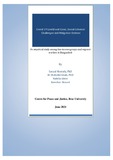| dc.description.abstract | The Covid-19 pandemic has caused substantial damages to the health and wellbeing of people around the world. As of February 1, 2021, Bangladesh recorded 535,000 infections with 8,100 deaths and a 90 percent recovery rate. In addition to the outbreak of the virus itself, the mitigation strategies to curb its spread, such as lockdown and social distancing, have significantly impacted the lives and livelihood of millions of people in Bangladesh. Amongst its other economic impacts, the costs of the pandemic are visible in the decline of Bangladesh’s export earnings and the return of thousands of migrant workers from overseas.
A decline in domestic demand has caused a marked rise in unemployment and thus a reduction of income. A significant number of industrial workers and micro-entrepreneurs of the formal and informal sectors, amongst others, have lost their access to economic activities. Reports suggest disproportionate sharing of the burden of the pandemic by marginalized groups, as well as increased risk and incidence of gender-based violence (GBV) in the country. In addition, there is concern that the social bondage, peace, and stability of the country, which has enabled Bangladesh to grow in the past few decades, is likely to be jeopardized. This challenges Bangladesh’s long-term development goals, including eradicating extreme poverty by 2030.
Against this backdrop, the Centre for Peace and Justice, Brac University (CPJ) undertook a study to understand the impacts of Covid-19 on select vulnerable groups. The study focused on two groups: low-income, urban formal and informal workers, and migrants who returned home to Bangladesh from abroad amid the pandemic (hereunder referred to as ‘returnees’).
The study had three objectives: a) Analyse the Covid-19-driven core livelihood challenges of people who belong to low-income groups and their livelihood challenges in relation to social cohesion; b) Explore their options and opportunities for coping with threats to social cohesion, and c) Identify strategies for Government of Bangladesh (hereunder referred to as ‘the Government’), NGOs, and communities to consolidate social cohesion. Here, low-income groups include garment workers, returnees and non-RMG workers (household aides, day labourers, transport workers like rickshaw pullers, drivers of motored three-wheelers and their helpers, microentrepreneurs, and low salaried persons in the private sector).
The study followed a normative view of social cohesion. It used a set of indicators generated from a social cohesion framework used in Latin America and the Caribbean to undertake an inter-country comparison of social cohesion. Social cohesion is understood in this study as a cumulated complementary behaviour of public institutions, society and community, which can be applied to overcome the livelihood challenges of the listed vulnerable households during the pandemic. Accordingly, the research framework used in this study included three thematic pillars: ‘Distance/divide’, ‘Institutional inclusion/exclusion mechanisms’, and ‘Sense of belonging’. Distance/divide is understood here as a manifestation of the equality or divides faced by low-income groups and migrants as opposed to other social groups not listed as low-income. Institutional inclusion and exclusion mechanisms are ‘actions carried out by various institutional actors’ in response to the felt ‘Distance’. Sense of belonging characterizes the complementary response of the community and society. The study has applied a set of indicators involving these three pillars and used them to formulate research questions.
To determine the state of social cohesion, the study used two types of proxy indicators, namely a) Impact Indicators and b) Outcome Indicators. The Impact Indicators were designed to help determine whether and how the social cohesion issues experienced by the surveyed population influenced their wellbeing during the pandemic as a result of behaviours of other stakeholders. These proxy impact indicators included: a) Perception of the survey population regarding unity and bondage in society, b) Observation of family relations (e.g., gender-based violence), c) Observation of conflicts in society attributed to the pandemic, and d) Observation of discrimination practised by service providers. The Outcome Indicators are related to the listed pillars (‘distance/divide’, ‘institutional inclusion/exclusion’, and ‘sense of belonging’). The ability of the surveyed population to cope with social cohesion issues (‘coping measures’) is also incorporated in the Outcome Indicators.
The Outcome Indicators under Distance/Divide include a) Job losses without severance, compensation, or other benefits, b) Loss of income, c) Relative trend of expenditures, d) Relative loss of assets, and e) Continuity of learning for children through an online system.
The pillar theme Exclusion/Inclusion is expressed through eight indicators: a) Public control over prices of necessary goods, b) Continuous access to social safety net where relevant, c) Access to emergency relief (from government, NGOs, and community), d) Access to public information and instructions on Covid-19, e) Access to medical care if needed during the pandemic, f) Existence of conflict resolution system, g) Public initiatives to substitute income loss, and h) Safeguards against discrimination.
The third pillar, Sense of Belonging, is characterized through four indicators: a) Affiliation with organisations to participate in decision making and raise voices, b) Access to benefits from affiliated organisations, c) Representation through organized entities (e.g., trade unions and similar interest groups), and d) Precedence of consultations by employers.
The state of Coping measures is reflected through five indicators: a) Vulnerability to lower food and nutritional intake due to income loss, b) Vulnerability to survive without practical external help, c) Use of savings and personal assets to survive, d) Opt for an alternative livelihood and e) Accumulation of debt (loans, rental payment, and utilities).
The study applied mixed-method research - quantitative research complemented by qualitative tools. A survey among 1,064 respondents belonging to the three groups (RMG workers, returnees and non-RMG workers) was conducted in November and December 2020. In addition to literature review, the team also conducted qualitative research through KIIs, FGDs, and unstructured interviews to complement and validate the findings of the quantitative study. | en_US |

